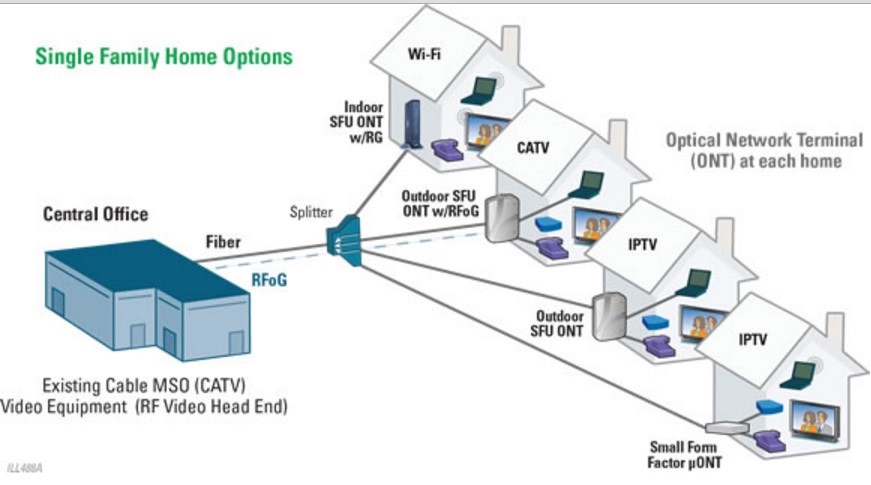Modern Edge Technologies has developed a full solution along with its partners to deliver PON including content for its clients. Call us to find out if a PON is the right solution for your business providing your clients’ full services that create your business a new profit center.
Voice – Video – Internet
Network elements[edit]
A PON takes advantage of wavelength division multiplexing (WDM), using one wavelength for downstream traffic and another for upstream traffic on a single mode fiber (ITU-T G.652). BPON, EPON, GEPON, and GPON have the same basic wavelength plan and use the 1490 nanometer (nm) wavelength for downstream traffic and 1310 nm wavelength for upstream traffic. 1550 nm is reserved for optional overlay services, typically RF (analog) video.
As with bit rate, the standards describe several optical power budgets, most common is 28 dB of loss budget for both BPON and GPON, but products have been announced using less expensive optics as well. 28 dB corresponds to about 20 km with a 32-way split. Forward error correction (FEC) may provide for another 2–3 dB of loss budget on GPON systems. As optics improve, the 28 dB budget will likely increase. Although both the GPON and EPON protocols permit large split ratios (up to 128 subscribers for GPON, up to 32,768 for EPON), in practice most PONs are deployed with a split ratio of 1:32 or smaller.
A PON consists of a central office node, called an optical line terminal (OLT), one or more user nodes, called optical network units (ONUs) or optical network terminals (ONTs), and the fibers and splitters between them, called the optical distribution network (ODN). “ONT” is an ITU-T term to describe a single-tenant ONU. In multiple-tenant units, the ONU may be bridged to a customer premises device within the individual dwelling unit using technologies such as Ethernet over twisted pair, G.hn (a high-speed ITU-T standard that can operate over any existing home wiring – power lines, phone lines and coaxial cables) or DSL. An ONU is a device that terminates the PON and presents customer service interfaces to the user. Some ONUs implement a separate subscriber unit to provide services such as telephony, Ethernet data, or video.
An OLT provides the interface between a PON and a service provider′s core network. These typically include:
IP traffic over Fast Ethernet, gigabit Ethernet, or 10 Gigabit Ethernet;
Standard TDM interfaces such as SDH/SONET;
ATM UNI at 155–622 Mbit/s.
The ONT or ONU terminates the PON and presents the native service interfaces to the user. These services can include voice (plain old telephone service (POTS) or voice over IP (VoIP)), data (typically Ethernet or V.35), video, and/or telemetry (TTL, ECL, RS530, etc.) Often the ONU functions are separated into two parts:
The ONU, which terminates the PON and presents a converged interface—such as DSL, coaxial cable, or multiservice Ethernet—toward the user;
Network termination equipment (NTE), which inputs the converged interface and outputs native service interfaces to the user, such as Ethernet and POTS.
A PON is a shared network, in that the OLT sends a single stream of downstream traffic that is seen by all ONUs. Each ONU only reads the content of those packets that are addressed to it. Encryption is used to prevent eavesdropping on downstream traffic.








